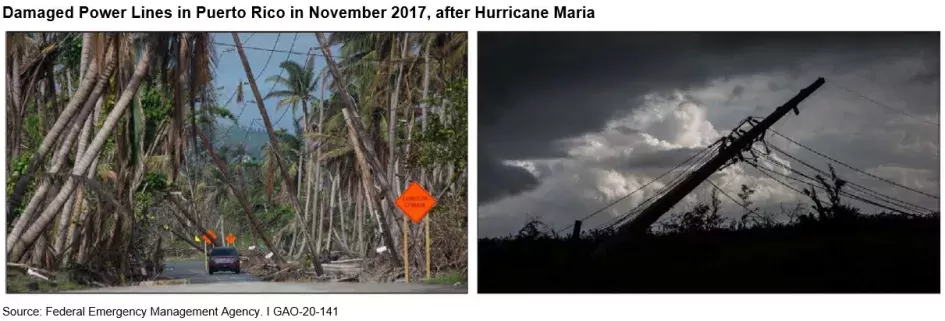Hurricane Recovery Can Take Years—But For Puerto Rico, 5 Years Show Its Unique Challenges
Recovery from a hurricane can take years. Communities often face challenges understanding and accessing federal programs meant to aid recovery, while facing obstacles like displacement and power outages. And, as we’ve seen in the wake of Hurricane Ian in Florida, individuals may also struggle navigating insurance policies. We have a large body of work looking at ways the federal government can improve how it helps communities recover from disasters. Most recently, we reported on ways the government can remove barriers communities face when trying to access federal assistance.
In September, when Hurricane Fiona struck Puerto Rico, it caused additional damage to an already vulnerable island that was still recovering from damage caused 5 years ago by Hurricanes Irma and Maria. The recovery from Hurricanes Irma and Maria has been the largest and most complicated in our nation’s history.
Today’s WatchBlog post looks at these unique challenges and our recent Congressional testimony about why recovery efforts in Puerto Rico have been delayed.
What damage was caused in 2017 and what assistance was made available?
Hurricanes Irma and Maria caused billions of dollars in damage to Puerto Rico. Puerto Rico’s government estimated it would need $132 billion from 2018 through 2028 to repair and replace the infrastructure damaged by the hurricanes.
Specifically, the hurricanes severely damaged Puerto Rico’s electricity grid, causing the longest blackout in U.S. history (11 months). To help restore electricity in the aftermath of the hurricanes, including temporary or partial repairs, federal agencies provided about $3.9 billion. In the years since Irma and Maria, we’ve reviewed efforts to rebuild the grid, but have seen little progress. In 2020, we found that FEMA had committed about $10 billion to fund longer-term grid recovery, but several steps remained before FEMA could approve projects, and there was uncertainty about how other available funding would support measures to enhance grid resilience. And when Hurricane Fiona hit in September, it further damaged an already vulnerable electricity grid.
In addition to the electricity grid—Puerto Rico’s roads, hospitals, schools, water systems, and other critical systems were damaged by Maria and Irma. FEMA has obligated about $28 billion to help the island recover from this damage. But we found that, as of August, the government of Puerto Rico has only expended about $5.3 billion (19%) of available funding. The funding Puerto Rico did use was largely spent on emergency work projects, such as debris removal.
Image

Why has recovery been delayed and why hasn’t Puerto Rico used more of the available recovery funding?
Just before Hurricane Fiona, GAO analysts visited Puerto Rico in March and July to get a better understanding of on-going recovery efforts from the 2017 hurricanes. Our teams met with federal, territorial, and local governmental officials, as well as nongovernmental organizations to discuss their observations and the challenges they face.
We testified about these challenges in September. Among their concerns, Puerto Rico's government and local entities said recovery efforts were challenged by:
- Limited institutional knowledge and capacity in Puerto Rico to manage disaster recovery programs
- Difficulties between FEMA and grant applicants in reaching agreement on the scopes for work for projects
- Increases in costs for projects because of inflation
- Difficulties in procuring resources such as goods and services for construction projects
These factors contributed to the slow recovery and the use of available funding.
What more can be done to help recovery efforts in Puerto Rico?
Five years after Hurricanes Maria and Irma, the recovery efforts in Puerto Rico are not where they need to be and will most likely will not get easier. Most of the federal dollars spent so far were for early response and emergency work, not permanent repairs and rebuilding of key infrastructure.
This lack of progress takes a human toll as well as a financial one. During his testimony in September, GAO’s Chris Currie talked about the impact of unspent dollars on the people of Puerto Rico. Over the course of several years after the 2017 hurricanes, Currie and GAO analysts visited a school in San Juan. They noted that the school looks worse today than it did right after Hurricane Maria struck.
FEMA has worked with Puerto Rico to improve the recovery efforts, including implementing several steps to streamline processes. FEMA has also provided training and technical assistance to help Puerto Rico’s government and local authorities with processing acquisitions and contracting.
But FEMA will need to continue to work with Puerto Rico as it builds its capacity to manage many billions of dollars and develops processes to ensure money is spent effectively.
Find out more about our work on Puerto Rico and the response to Hurricanes Irma and Maria by reading our recent testimony and February 2020 report.
- Comments on GAO’s WatchBlog? Contact blog@gao.gov.







